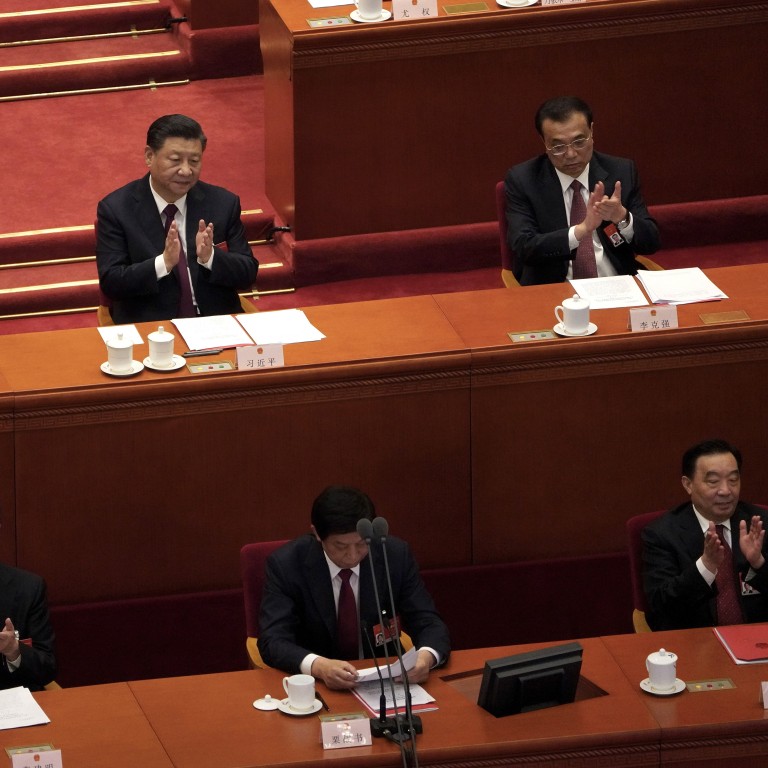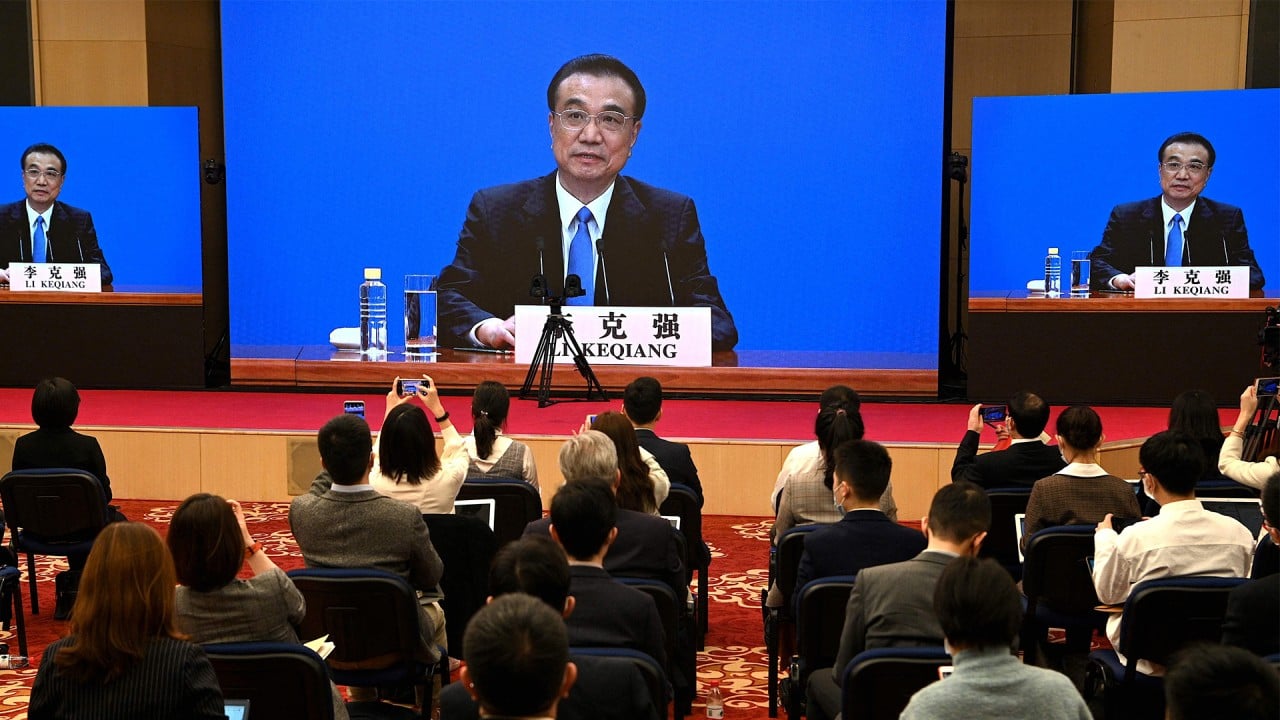
China’s goal of productivity growth faster than the overall economy hinges on rural education, innovation
- China is in need of new sources of growth after the old growth model propelled by investment began running out of steam
- Beijing laid out its plans in the draft of its 14th five-year plan for 2021-25 released last week at the ‘two sessions’ in Beijing
After breaking with tradition and opting to not set targets for economic and labour productivity growth for the next five years, the success of China’s vague goal of aiming for productivity growth higher than that of the overall economy hinges on a major improvement in rural education and innovation, analysts said.
The growth of labour productivity, measured by gross domestic product (GDP) per worker, has remained high and in line with GDP growth over the past five years, owing largely to high investment. Last year, it grew by 2.5 per cent, higher than the overall economic growth rate of 2.3 per cent, according to the National Bureau of Statistics.
Yet, China’s productivity challenge remains as a broader measure of how efficiently an economy uses capital and labour, also known as total factor productivity (TFP).
The labour force will keep shrinking, at a faster rate, and deleveraging means slower investment and capital accumulation
“The labour force will keep shrinking, at a faster rate, and deleveraging means slower investment and capital accumulation. This has caused TFP growth to fall a lot in recent years – we estimate [its growth rate] was less than 2 per cent in the five years through 2020 compared to over 5 per cent a decade ago,” said Shaun Roache, chief economist for Asia-Pacific at S&P Global Ratings.
That estimate is not far from Beijing’s own analysis as in a joint report with the World Bank published in 2019, the Development Research Centre under the State Council said that the TFP growth rate had fallen to an average of 1.55 per cent between 2008 and 2017 – less than half the 3.5 per cent rate in the decade before the 2008 global financial crisis – with little improvement in recent years.
By 2025, Beijing plans to increase the average number of years spent in school to 11.3 from 10.8. Economists believe increasing high school attainment, particularly in China’s rural areas, is key to meeting that goal.
As recently as 2016, fewer than half of the students in rural China attended high school, compared to more than 90 per cent in big cities, according to a 2016 study of more than 24,000 rural students by scholars from the United States and China.
This gap was partly attributed to the fact that many rural children opted to follow their parents’ footsteps and find manual work in cities after dropping out of school.
We do worry that too much state intervention could damage productivity growth
A hukou is a household registration document that all Chinese citizens must have that controls access to public services based on their birthplace, but migrant workers who hold hukou from their hometowns will have very limited rights to public services in any other city that they move to for work.
Rozelle added that no country with less than 50 per cent high-school attainment has ever been able to avoid the trap.
“We do worry that too much state intervention could damage productivity growth, however,” Roache said. “The major productivity booms we have seen since 1978 [in China] have followed reforms that have allowed the private sector to play a greater role in the economy. In recent years, the economic footprint of state-owned enterprises has begun to rise again, including in new economy areas.”

05:13
Chinese premier addresses Hong Kong electoral changes, US-China relations, as ‘two sessions’ closes
There was a sizeable gap of around 20 per cent in TFP between state-owned enterprises and private firms in 2019, mainly due to low returns on investment among state firms. It remains a question whether including labour productivity as part of SOE performance reviews starting from this year, as the government has proposed, will narrow the gap.
China’s total productivity is currently only around half the average level of countries that are members of the Organization for Economic Cooperation and Development, nations which are mostly developed countries, according to the World Bank.
At the same time, increasing competition with the US could also limit China’s access to the world’s most advanced technologies and drag down its productivity growth.
China’s response to this – whether China should rely on its government-mandated industrial policies to advance its technological goals or give the market a bigger role in driving innovation – has generated a lively debate among researchers.
Trying to wean the economy off foreign technology could also hurt productivity because China will be less able to exploit the new ideas and products in the rest of the world
“Trying to wean the economy off foreign technology could also hurt productivity because China will be less able to exploit the new ideas and products in the rest of the world,” Roache added.
“China’s economy has huge resources, but it may not be able to have innovation across all domains at the same time. China’s most advanced manufacturing output still relies heavily on foreign technology, all the way through the supply chain.”
While the central government has downplayed growth targets to dampen incentives at the local level to recklessly pursue increases in output, there has been a revival of industrial policies to boost China’s self reliance in “strategic areas” such as semiconductors and software.
“The risk to this shift in priorities is clear. If officials are judged less by whether they can deliver growth than whether they can shovel money at ‘innovation’ related projects, then the risk of waste and distortions has not necessarily been reduced, and could increase,” said Andrew Batson, head of China economic research at consultancy firm Gavekal.
S&P’s research has shown that while China is likely to be able to arrest its declining labour productivity rate, it will be difficult to reverse it.
It has projected that China’s real GDP growth rate in 2025 will be 5.1 per cent, while TFP growth will be only about 2 per cent. In 2030, real GDP growth is estimated to be 4 per cent and TFP growth 1.7 per cent.
Larry Hu, chief China economist at Macquarie, said that a GDP growth target still matters in China’s long term economic planning.
If they can lift labour productivity, it would be the best. But if they can’t raise it, they’ll go back to stimulus. This is for sure
At a fundamental level, China’s economic system can be best described as “state capitalism” and the “state” portion does need planning, as without a target, it will lose its way and be unable to function appropriately, Hu added.
“When the economy isn’t doing well, it means there’ll still be stimulus,” Hu said. “It also means you can’t always have it all. I think that they’ll monitor and make adjustments.
“If they can lift labour productivity, it would be the best. But if they can’t raise it, they’ll go back to stimulus. This is for sure.”


